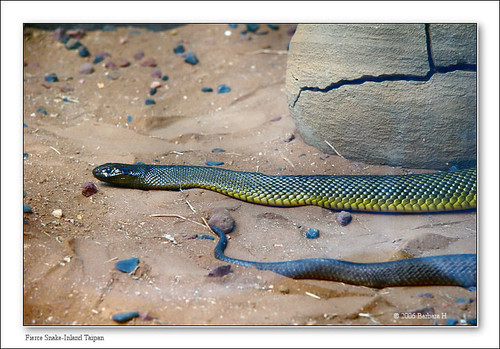
1) Fierce Snake or Inland Taipan (Oxyuranus microlepidotus ), Australia. The most toxic venom of any snake. Maximum yield recorded (for one bite) is 110mg. That would porbably be enough to kill over 100 people or 250,000 mice. With an LD50 of 0.01 mg/kg, it is about 10 times as venomous as a Mojave rattlesnake and 750 times as venomous as a common cobra. The Fierce Snake is native to the arid regions of central Australia, extending from the southeast part of the Northern Territory, and into west Queensland. The Fierce Snake can also be found north of Lake Eyre and to the west of the split of the Murray River, Darling River and Murrumbidgee River. Fierce Snakes are known to live in holes, and feed on small rodents such as mice and rats. Despite its name, Fierce Snakes are not known to be particularly aggressive, but docile. They will strike if provoked, however, injecting their incomparably toxic venom.No fatalities have been attributed to this species, and all known bites have been to people who keep them in captivity or actively seek them out in the wild.
Eastern Brown Snake, originally uploaded by wollombi.
2) Australian Brown Snake (Pseudonaja textilis ), Australia. One 1/14,000 of an ounce of this vemon is enough to kill a person. The Eastern Brown Snake (Pseudonaja textilis) – sometimes referred to as the Common Eastern Brown Snake is the world’s second most venomous land snake, native to Australia and may also be found on the peninsulas of Papua New Guinea and Indonesia. Eastern Brown Snakes are very fast moving and highly aggressive. When agitated, they will hold their necks high, appearing in a somewhat upright S-shape. The snake will occasionally chase an aggressor and strike at it repeatedly.
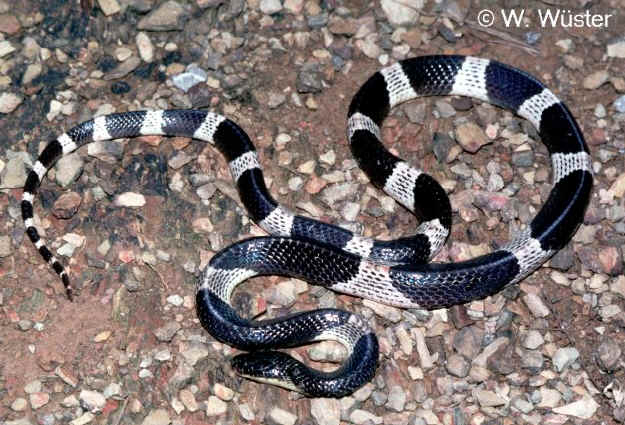
3) Malayan or Blue Krait (Bungarus candidus ), Southeast Asia and Indonesia. 50% of the bites from this snake are fatal even with the use of antivenin treatment.
Kraits are ophiophagous, preying primarily upon other snakes (including venomous varieties) and are cannibalistic, feeding on other kraits. They will also eat small lizards.
All kraits are nocturnal. The snake is more docile during the daylight hours, becoming more aggressive during the night. However, they are rather timid and will often hide their heads within their coiled bodies for protection. When in this posture, they will sometimes whip their tail around as a type of distraction.
Deadly Taipan Snake-04+,
4) Taipan (Oxyuranus scutellatus ), Australia. The venom delivered in a single Taipan bite is enough to kill up to 12,000 guinea pigs. The common taipan is the third-most venomous snake on Earth and arguably the second-largest venomous snake in Australia (the first arguably being the mulga, or king brown, snake, Pseudechis australis). The danger posed by the coastal taipan was brought to Australian public awareness in 1950, when young herpetologist Kevin Budden was fatally bitten in capturing the first specimen available for antivenom research.
5) Tiger Snake (Notechis scutatus ), Australia.
All Notechis species have a very potent neurotoxic venom, which may cause neurotoxic, hemolytic, coagulopathic, and myolytic reactions; paralysis or death can ensue in as short as 30 minutes, but if it occurs it is usually on the timespan of 6-24 hours after the bite. Notechis has historically been a significant contributor to snakebite envenomation in Australia. Prior to the development of specific antivenom, Tiger Snake bite fatalities probably approached 60-70% in cases of severe bites. Specific antivenoms are available for the treatment of tiger snake bites. Fortunately the snake will generally flee if intruded upon, but will become aggressive if cornered.

6) Beaked Sea Snake (Enhydrina schistosa )
This is a species of sea snake.It is found in the Arabian Sea and Persian Gulf (off Oman), south of the Seychelles and Madagascar, the seas off South Asia (Pakistan, India and Bangladesh), Southeast Asia (Myanmar (formerly Burma), Thailand, Vietnam), and Australia (Northern Territory and Queensland) and New Guinea.
Found in mangrove swamps.
Echis carinatus, originally uploaded by Drew Gardner.
7) Saw Scaled Viper (Echis carinatus ), Middle East Asia.
Echis carinatus is a venomous viper species found in parts of the Middle East and Central Asia, and especially the Indian subcontinent. It is the smallest of the Big Four dangerous snakes of India. Five subspecies are currently recognized, including the typical form described here.
This species is mostly crepuscular and nocturnal, although there have been reports of activity during daylight hours. [2] During they daytime they hide in all kinds of places, such as deep mammal burrows, rock fissures an fallen rotted logs. In sandy environments, they may bury themselves leaving only the head exposed. Often, they are most active after rains or on humid nights.
When alarmed, they put on a distinctive threat display.
They move about mainly sidewinding: a method at which they are considerably proficient and alarmingly quick. They are also capable of other forms of locomotion, but sidewinding seems to be best suited to moving about in their usual sandy habitats. It may also keep them from overheating too quickly, as they leave only two points of contact with the hot surface.
This species is often found climbing in bushes and shrubs, sometimes as much as 2 m above the ground. When it rains, up to 80% of the adult population will climb into bushes and trees. Once, it was observed how some 20 individuals had massed on top of a single cactus or small shrub.
Texas Coral Snake4,
8 ) Coral Snake (Micrurus fulvius ), North America.
The coral snakes are a large group of elapid snakes that can be divided into two distinct groups, New World coral snakes and Old World coral snakes. There are three genera among New World coral snakes that consist of over 65 recognized species.
Coral snakes vary widely in their behavior, but most are very secretive, fossorial snakes which spend the vast majority of their time buried in the ground or in leaf litter of a rainforest floor, only coming to the surface during rains or during breeding season. Some species, like Micrurus surinamensis are almost entirely aquatic and spend most of their lives in slow moving bodies of water that have dense vegetation.
Like all elapid snakes, coral snakes use a pair of small fangs, which are fixed in the front of their top jaw, to deliver their venom. Due to the time it takes for the venom take effect, coral snakes have a tendency to hold on to a victim when biting, unlike vipers which have retractable fangs and tend to prefer to strike and let go immediately. Coral snakes are not aggressive or prone to biting however, and account for less than a single percent of the number of snake bites each year in the United States. Most coral snake bites occur because of accidental handling of the snake while engaged in an activity like gardening.
Due to the small size of coral snakes, along with their having much smaller fangs than pit vipers, bites are frequently ineffective and have some difficulty penetrating shoes or even thick clothing. This along with the fact that coral snakes are quite shy and reclusive makes bites quite rare. However, coral snakes are highly venomous, being the only relative of the cobra found in the New World. Despite their relatively small size, their venom is a powerful neurotoxin, quite capable of killing an adult human. Any bite from a coral snake should be considered life threatening and immediate treatment should be sought. Often there is very little reaction around the bite area, as opposed to the pain and swelling usually associated with a viper bite, and systemic effects can delay manifestation for 8-24 hours. This potential delay in symptoms makes treating coral snake bites particularly tricky, and often results in preventative treatment whether one is displaying symptoms or not. Once the neurotoxin takes effect, it causes the neurotransmitters between the brain and muscles to malfunction. Initially symptoms are slurred speech, double vision, difficulty swallowing, but can quickly progress to muscular paralysis, and even respiratory or cardiac failure if not treated.
Boomslang,
9) Boomslang (Dispholidus typus ), Africa.
A boomslang, Dispholidus typus is a large, venomous colubrid snake native to sub-Saharan Africa. It is the only species in its genus. Its name means “tree snake” in Afrikaans and Dutch.Boomslangs are largely arboreal, are very fast moving, and are oviparous. Their diet includes chameleons and other arboreal lizards, frogs, and occasionally small mammals, birds and eggs from nesting birds, which they swallow whole.
Most members of the colubrid family are harmless, or have relatively weak venom, but the boomslang is an exception. It has a highly potent venom which it delivers through large, deeply grooved fangs that are (like in most other venomous colubrids) located in the rear of the jaw. This type of venomous apparatus is called opisthoglypha. The boomslang is the most dangerous of the snakes with this method of venom delivery, due to its relatively large fangs and its relatively anterior position of the fangs compared to other opisthoglyphic taxa. The bite of the boomslang can be fatal, and has been reported to be not unlike bites from vipers. In 1957, well known herpetologist, Karl Schmidt died after being bitten by a boomslang. D.S. Chapman states that between 1919 and 1962 there were eight serious human envenomations by boomslangs, two of which were fatal. The South African Vaccine Producers (formerly South African Institute of Medical Research) manufactures a monovalent antivenom for boomslang venom. The venom of the boomslang is primarily a hemotoxin. This means that the venom attacks and destroys the hemoglobin in the red blood cells, destroying the blood in its victim. The venom of a boomslang disables blood clotting process and the victim often dies out of numerous internal and external bleedings. Other symptoms include: headache, nausea, sleepiness and mental disorders. Being a relatively slow-acting venom, the symptoms may occur many hours after the bite. On one hand, this provides time for arranging the serum, while on the other hand it may lead victims to underestimate the bite (especially when, as with other snakes, not every bite injects venom).
An adult snake has 4-8 mg of venom. 5 mg is said to be enough to kill a man.
The boomslang is a timid snake, and bites generally occur only while attempting to handle, catch or kill the snake.
death adder – acanthophis antarcticus, originally uploaded by fraser baz.
10) Death Adder (Acanthopis antarcticus ), Australia and New Guinea.
Death adders are very viper-like in appearance, having triangular shaped heads and small subocular scales. They also have vertical pupils and many small scales on the top of the head. Like vipers, they have short, fat bodies (normally 50 – 90 cm (20 – 36 inches) long). Their fangs are also longer and more mobile than for most other elapids, although still far from the size seen in some of the true vipers. Despite their name and appearance, they are not vipers at all, but elapids (like all Australian venomous snakes). This is a case of convergent evolution.
It normally takes 2 – 3 years to reach adult size. Females are generally slightly larger than the males. They can also be easily distinguished from other Australian snakes because of a short spine protruding from their tails. Most have large bands around their bodies, though the color itself is variable. Colors are usually grey or red, but also include brown, greenish-grey, or yellow.
Death adders inject on average 40 – 100 mg of extremely toxic venom (0.4 – 0.5 mg/kg murine LD50, subcutaneous) with a bite. This makes an untreated death adder bite one of the most dangerous in the world (rated in top 10 in the CSL list).
Death adder venom is highly neurotoxic. It blocks the post-synaptic neuromuscular transmission from the acetylcholine receptor. Unlike other snakes of its type, it does not contain either procoagulants or myolysins, making treatment easier.
A bite from a death adder causes paralysis. While this paralysis is very minor at first, it can cause death from a complete respiratory shutdown in as little as six hours. Symptoms peak in 24 – 48 hours.
Symptoms of envenomation can be reversed through the use of death adder antivenom, or using anticholinesterases, which break the synaptic blockade by making acetylcholine more available to the brain.
Before antivenom was introduced, 50% of death adder bites were fatal. Now, with the antivenom, and due to the slow progression of envenomation symptoms, fatalities from death adder bites are very rare in Australia. In New Guinea, deaths from these snakes are still common.










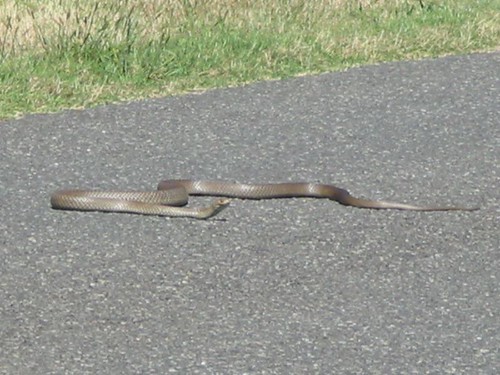
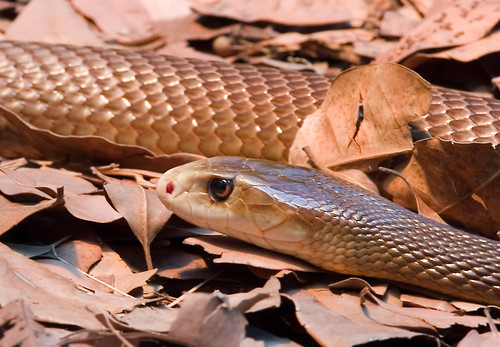
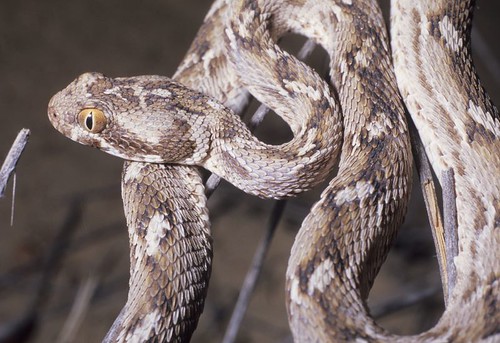
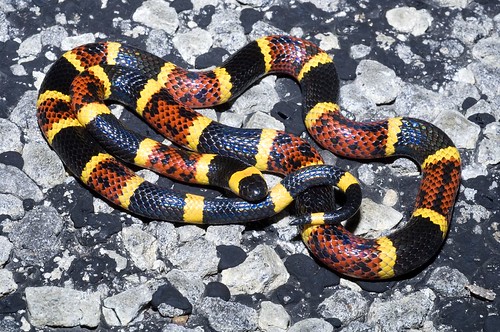
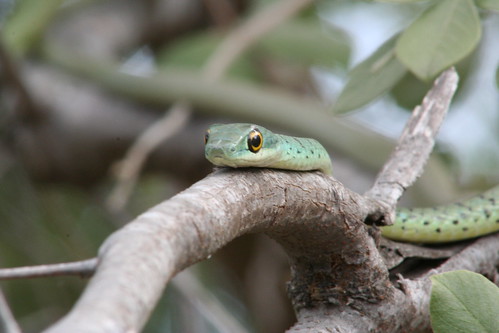
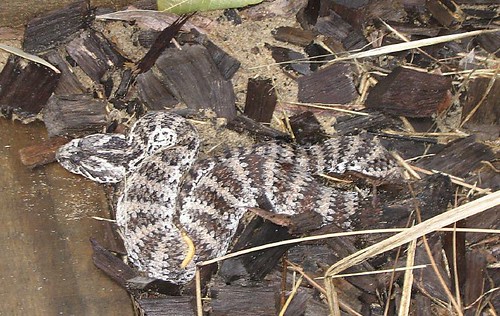
























No comments:
Post a Comment